GAM LSA Private Shares AU Fund
Companies are staying private for longer and the fund provides access to a portfolio of leading, privately owned growth companies.
Companies are staying private for longer and the fund provides access to a portfolio of leading, privately owned growth companies.
The Fund invests in a portfolio of global small and mid-cap companies poised to grow their profitability and investor returns.
The fund aims to provide investors with the performance of the S&P Small-Cap 600®, before fees and expenses. The index is designed to measure the performance of small-capitalisation US equities.
8I Holdings Limited is an Australia-listed investment holding company committed to strategic holdings management. With a vision centred on empowering growth and transforming lives, 8I dedicates its efforts to creating a positive impact and fostering empowerment.
Vanguard MSCI International Small Companies Index ETF seeks to track the return of the MSCI World ex-Australia Small Cap Index (with net dividends reinvested) in Australian dollars before taking into account fees, expenses and tax.
Invest in unique, high-growth private and public technology companies in Australia, the USA and offshore.
The Fund aims to outperform the MSCI ACWI SMID Cap Index (after fees and expenses and before taxes) on a rolling five-year basis.
QSML gives investors a diversified portfolio of 150 international developed market small-cap quality growth securities. QSML aims to provide investment returns before fees and other costs which track the performance of the Index.
The Fund invests in small and midcap listed global equities with aims for returns greater than the MSCI All Country World Index SMID Cap unhedged in Australian dollars over rolling 3 year periods after fees.
QHSM gives investors a diversified portfolio of 150 international developed market small-cap quality growth securities with returns hedged into Australian dollars. QHSM aims to provide investment returns before fees and other costs which track the performance of the Index.
The investment objective of the Fund is to provide long-term capital growth by gaining exposure to a diversified portfolio of small companies associated with approved developed markets (excluding Australia).
Discover everything you need to know about Global Small Cap Equity Funds, including their diversification benefits and growth potential, the associated risks, and how to invest in them through various fund structures, including ETFs and managed funds.
Global Small Cap Equity Funds are investment funds that pool money from multiple investors to buy shares in smaller companies, typically with market capitalisations between $250 million and $2 billion, listed on stock exchanges worldwide. These funds offer exposure to both developed and emerging markets, giving investors access to the growth potential of international small-cap companies.
These funds provide diversified exposure to global portfolios of smaller companies. They are managed by professional fund managers, or by tracking global small cap indices like the MSCI World Small Cap Index, which comprises almost 4,000 stocks from 23 developed countries. Global Small Cap Funds are popular with Australian investors as they provide access to global innovation and niche market leaders with higher growth potential than much of Australia’s limited Small Cap universe.
Before we dive in, here’s a brief definition of some key terms Global Small Cap Equity Fund investors need to understand:
The Global Small Cap Equity Market encompasses over 12,000 publicly listed companies across 47 developed and emerging markets, and represents 87% of the constituents of the global equity market universe.
The main Global Small Cap index is the MSCI World Small Cap Index with almost 4,000 constituents, while there are also regional variants covering North America, Europe, and Asia-Pacific markets. The MSCI World Small Cap Index is dominated by American stocks which comprise 59% of the index, while Japanese companies represent 13% and Australian stocks represent only 4% of the index.
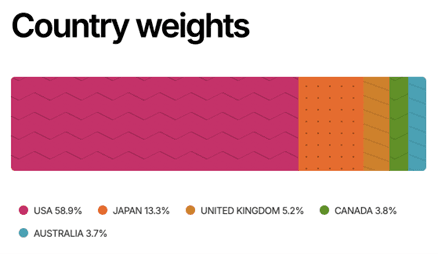
The index demonstrates significant sector diversification with overweight positions in Industrials, Real Estate, and Materials compared to Large Cap indices, while being underweight in Information Technology and Communication Services.
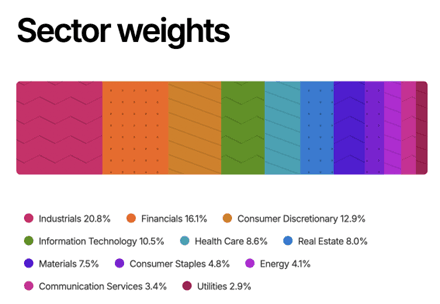
Global Small Cap Equity Markets are influenced by interest rate cycles, with smaller companies demonstrating higher sensitivity to rate changes than their larger peers due to their greater reliance on floating-rate debt and reduced access to capital markets.
Economic growth cycles also significantly impact Small Cap performance as smaller companies typically exhibit higher cyclicality and domestic market exposure compared to multinational Large Caps.
Currency fluctuations, geopolitical events, and sector rotation between growth and value investing styles also drive market movements.
The MSCI World Small Cap Index has historically delivered solid long-term returns of 8.9% p.a. since its inception on December 29th, 2000. The index has outperformed the MSCI World Index over the past 20+ years, though recent performance has lagged due to interest rate headwinds.
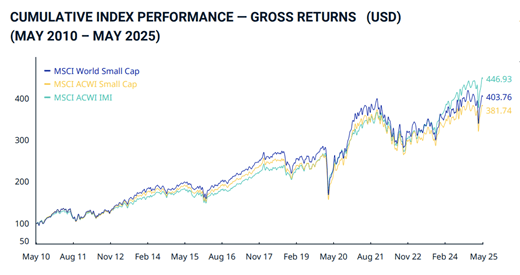
Looking ahead to 2025, most analysts expect Global Small Caps to benefit from rate-cutting cycles in many developed markets which is expected to lead to stronger earnings growth. With lower valuations than their Large Cap peers, Global Small Caps appear well positioned to outperform in the coming years.
In the words of Vanguard:
‘With their compelling diversification benefits, as well as the current valuation discounts on offer, global Small Cap stocks can enhance a global equity portfolio’s risk-adjusted performance. The specific characteristics of Small Caps, combined with effective, low-cost index fund implementation, make them an important building block for equity investors.’
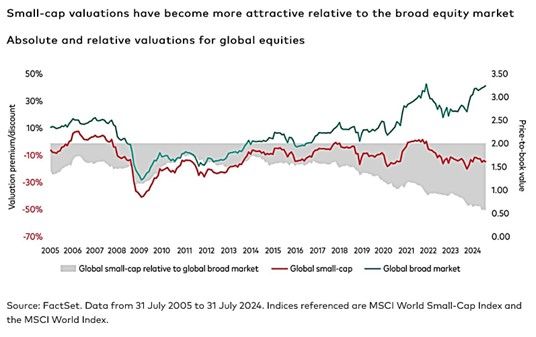
CCL further highlights the diversification benefits of investing in Small Caps:
‘The last several years has witnessed increased concentration in the global large cap developed equity market index. Introducing a global small cap equity component to portfolios can provide a complimentary source of diversification, a broader opportunity set of less externally researched companies, and thereby offering the potential for delivering returns above the index through active management.’
The CFA Institute concur and believe recent Small Cap underperformance versus Larges Caps is drawing to an end:
‘We’re in the 12th year of a small-cap lagging cycle, longer than average. Historical data suggests a reversal is near.’
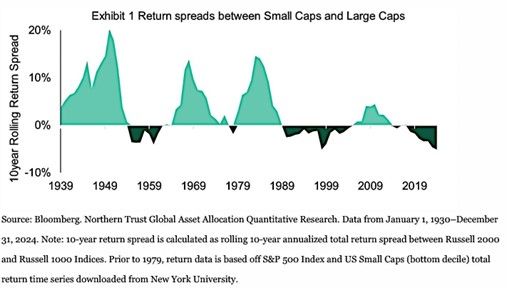
Global Small Cap Equity Funds cater to various investment strategies, risk appetites, and access methods, with major Australian providers including Artisan, Pengana, and DS Capital.
Here are the main types of funds available:
Global Small Cap Equity Managed Funds are professionally managed funds that invest in the shares of smaller companies across major global markets, offering investors diversified exposure to many markets.
Investors can access these funds through direct applications with the fund managers. Most require minimum investments typically starting from $25,000. Managed fund fees in Australia are typically 0.75-1.5% p.a.
Global Small Cap Managed Funds like Artisan Global Discovery Fund employ professional fund managers who actively select international Small Cap stocks with the objective of outperforming their benchmark through research and stock-picking.
Exchange Traded Funds aim to replicate Global Small Cap market indices at lower costs than managed funds, while providing broad diversified exposure to thousands of international small companies. They combine diversification benefits with trading flexibility on the ASX. The average management fee charged for an Australian ETF is 0.54% p.a.
Passive ETFs represent the most common type. These ETFs track broad Global Small Cap indices such as the MSCI World Small Cap Index or the MSCI World ex Australia Small Cap Index. Popular Global Small Cap ETFs include Vanguard MSCI International Small Companies Index ETF (ASX: VISM) which provides exposure to over 3,700 international Small Cap stocks for a management fee of 0.32% p.a.
Active ETFs are becoming more popular. These funds feature professional management aimed at outperforming their benchmarks while maintaining the benefits of an ETF’s structure and liquidity, although the Global Small Cap options remain limited in the Australian market.
Global Small Cap Funds offer both currency-hedged and unhedged variants to manage foreign exchange risk.
Currency Hedged Funds like WisdomTree Dynamic Currency Hedged International SmallCap Equity Fund use sophisticated hedging strategies to minimise AUD exchange rate impact on returns.
Unhedged Funds like Vanguard MSCI International Small Companies Index ETF (ASX: VISM) provide full exposure to currency movements, potentially benefiting investors when the AUD weakens and costing them performance when it strengthens.
Regional Small Cap Funds focus on specific geographic areas such as the U.S., Europe, or the Asia-Pacific region.
Style-Specific Small Cap Funds include quality-focused options like VanEck MSCI International Small Companies Quality ETF (QSML), which targets companies with high return on equity, stable earnings growth, and low financial leverage.
ESG and Sustainable Global Small Cap Funds screen investments based on environmental, social, and governance criteria. It’s noteworthy that some Global Small Caps are innovating in sustainability and renewable energy.
Specialised funds target specific Global Small Cap sectors, including technology innovation, healthcare and biotechnology, renewable energy, and industrial automation. These funds typically carrying higher risk and are generally better suited for satellite portfolio positions.
If you want to invest in international small companies, you’ll usually choose between two options: Global Small Cap ETFs (exchange traded funds) and Global Small Cap managed funds (also known as mutual funds). Here’s how they compare:
How They’re Bought and Sold
Expert insight: Morningstar notes that while being able to trade ETFs instantly sounds great, it’s not always an advantage for most investors. Investing legend Jack Bogle actually disliked ETFs at first because people might trade too much.
Fees and Costs
Transparency
Minimum Investment & Accessibility
There are a number of key benefits of investing in Global Small Cap Funds:
Global Small Cap Funds provide access to over 12,000 international companies across 47 countries, reducing single-country risk and providing exposure to different economic cycles beyond Australia’s limited Small Cap universe.
This diversification enables access to innovative sectors and niche market leaders underrepresented on the ASX such as technology innovators and renewable energy pioneers.
Global Small Cap Funds provide access to ownership stakes in emerging companies with proven business models and significant growth potential. These businesses may be well-positioned to evolve into Large Caps of the future.
According to Artisan Partners:
‘Compared to international large caps, international small caps can potentially provide investors exposure to faster growth outside the US while selling at similar valuations. Moreover, international small caps have also generated faster earnings growth than US small caps over the past five years and currently have higher returns on capital, boast better balance sheets, pay higher dividend yields and sell more cheaply.’
International Small Cap exposure provides natural currency hedging against AUD depreciation, with unhedged Global Small Cap Funds benefiting when the Australian dollar weakens relative to major international currencies.
Global Small Caps derive only 1% of their revenue from Australia compared to 70% for Australian Small Caps, so they offer compelling currency diversification benefits.
Some Global Small Caps are innovation leaders in sustainability, renewable energy, and emerging technologies. These companies frequently dominate niche markets and specialised industries with significant barriers to entry. Moreover, their smaller, more focused business models can help enable rapid adaptation to changing market opportunities.
Global Small Caps often demonstrate a lower correlation to Large Cap performance, so they can provide valuable diversification benefits. They also offer the potential for alpha generation through active management in less efficient markets.
According to State Street:
‘Within a diversified portfolio, small caps can enhance portfolio characteristics while potentially reducing the frequency of severe drawdowns. Implementing small-cap approaches at scale requires careful consideration of implementation costs. A combined active, passive, and enhanced approach can balance alpha potential with implementation feasibility.’
Investing in Global Small Cap Equity Funds can offer strong growth, but there are several risks to be aware of:
If the fund is unhedged, changes in exchange rates can boost or reduce your returns, regardless of how the companies themselves are performing. If the Australian dollar gets stronger, your international returns can fall. Currency hedged funds can help, but they come with extra costs and risks.
Global small caps often experience bigger ups and downs than larger companies. They are more sensitive to economic cycles and interest rate changes because smaller companies usually have less access to funding and are more affected by rising rates.
Shares in smaller companies usually trade less frequently than big-name stocks. This can make it harder to buy or sell during market stress. Also, because there’s less research available, it can be harder for investors to get information about these companies.
Even with lots of companies in the fund, global small cap indexes can end up heavily weighted in certain regions or sectors. For example, US companies make up nearly 60% of the MSCI World Small Cap Index. Smaller companies are also more likely to struggle or fail compared to larger firms.
International investing can bring extra tax headaches, like foreign withholding taxes and complicated reporting. You’re also exposed to different rules and political changes in each country where the fund invests.
Accessing Global Small Cap Equity Funds involves multiple pathways catering to various investor preferences:
To access Global Small Cap ETFs, investors require ASX trading access through an online broker. Popular platforms include CommSec which offers trading in global ETFs, Westpac Share Trading which provides access to 25+ international exchanges, CMC Markets with low brokerage on select global ETFs, and Stake which specialises in U.S. market access.
Key considerations when selecting a broker include brokerage fees (typically ranging between $0-$29.95), international market access, currency conversion costs, and research tools.
ASIC advises investors to be wary of brokers marketing ‘zero’ or ‘low-cost’ brokerage to attract clients: ‘some of these claims of “zero” or “low-cost” brokerage were not true to label, particularly where other fees and charges were payable by the client or where the service was “bundled” with other products or services that effectively subsidised the brokerage and caused retail investors to take on additional risk.’
Unlisted Global Small Cap Equity Funds require direct applications through fund managers’ websites or financial advisers. For example, fund providers like Artisan Partners and Pengana offer direct access to their Global Small Cap funds. Applications typically involve completing investment forms, providing relevant identification, and meeting the minimum investment thresholds usually being $25,000+.
Investment platforms provide consolidated access to multiple Global Small Cap Fund managers through single accounts, often with reduced paperwork and consolidated international reporting. These platforms typically charge additional administration fees of 0.2-0.5% p.a., but offer the convenience of diversified global fund portfolios and currency management.
Financial advisers can assist with Global Small Cap Fund selection, currency hedging decisions, and international portfolio construction, which is particularly valuable for investors seeking personalised advice on geographic allocation. Adviser fees typically range between 0.5-1.5% p.a. plus potential upfront charges for any advice received.
Most superannuation funds offer Global Small Cap Equity investment options within their investment menus, including both active and passive alternatives. Self-managed super funds (SMSFs) also provide direct access to global opportunities with potential tax advantages on offer.
Understanding the tax implications is essential for maximising the after-tax returns of Global Small Cap Fund investing:
International dividends from income-paying Global Small Cap Funds are subject to foreign withholding taxes ranging between 0-30% depending on the source country and any applicable tax treaties.
Morningstar explain:
‘In the eyes of the ATO, any investment income you earn in or out of the country must be taxed. In most cases, the country you’re investing in will also require the investment to be taxed. In the US, this is done automatically through withholding tax of 15%. Not all countries withhold tax. The United Kingdom is one example.’
Australian residents can claim foreign tax credits to offset any payable withholding taxes against their Australian tax liability, which prevents double taxation on their international Small Cap income.
According to the ATO: ‘As an Australian resident, you must declare any foreign income you earn on your Australian tax return.’ ‘If you have already paid tax in the country where you derived the income, you may be able to claim an Australian foreign income tax offset.’
Global Small Cap ETFs typically provide annual tax statements detailing foreign income and any applicable credits.
For Australian investors, Global Small Cap ETFs distribute foreign dividends and capital gains, often with foreign tax credits for withholding taxes. Also, selling ETF units may trigger capital gains tax (CGT), with a 50% discount for holdings over 12 months.
Global Small Cap Managed Funds also distribute foreign dividends, interest, and capital gains, each one of which is taxed differently. Notably, investors may incur CGT on distributed gains without selling fund units, as managed funds pass through their tax liabilities annually thereby increasing their tax complexity.
Currency-hedged Global Small Cap Funds may generate foreign exchange gains or losses that are taxable as ordinary income rather than capital gains. These currency adjustments are typically included in their annual distributions and require careful tax planning.
Global Small Cap investments require detailed record-keeping of foreign income, withholding taxes, and currency conversion rates for Australian tax compliance.
According to Morningstar: ‘Every part of your tax return must be filed in Australian dollars. When you’re declaring income from international investments, two rates must be used depending on the circumstance.’
Professional tax advice is recommended for substantial international Small Cap investments.
Constructing a robust Global Small Cap Fund portfolio requires strategic planning aligned with investors’ objectives and risk tolerance:
Clear goal definition drives effect Global Small Cap Fund selection, whether it be prioritising broad international diversification, regional exposure, or thematic investing in innovation sectors.
Risk tolerance assessment determines the appropriate allocation with many sophisticated investors capping their Global Small Cap exposure at around 15% of their equity allocations as this is consistent with MSCI market coverage percentages.
Some investors establish core holdings in broad Global Small Cap ETFs or Managed Funds like Artisan Global Discovery which often represent 60-80% of their Global Small Cap allocation. In addition, they invest in satellite positions in regional, sector-specific, or thematic Global Small Cap Managed Funds which can comprise 20-40% of their Global Small Cap allocation.
This core-satellite approach balances broad international Small Cap diversification with targeted exposure to preferred global themes or innovation sectors.
Strategic decisions on currency hedging depend on investors’ AUD outlook and risk tolerance, with some advisers recommending balanced exposure between hedged and unhedged Global Small Cap Funds. Currency-hedged funds provide protection during periods of AUD strength, while unhedged funds benefit from AUD weakness and offer natural currency diversification.
Most successful Global Small Cap portfolios are well-diversified across regions and sectors. Consider avoiding funds with over-concentration to any single region or thematic area.
Regular portfolio rebalancing maintains target allocations after various Global Small Cap regions and sectors outperform or underperform. Quarterly or semi-annual rebalancing helps capture gains from winning positions while adding to underperforming areas.
Successful Global Small Cap Equity Fund investing requires a long-term perspective to benefit from international economic growth and the compounding of returns. Regularly reinvesting distributions and dollar cost averaging enables compounding to work effectively across global markets.
Effective monitoring ensures that Global Small Cap Funds continue to align with investors’ objectives while avoiding excessive trading:
Monitoring KPIs like Total Return offers investors a comprehensive view by combining capital gains, dividends, and currency impacts. Evaluating currency impact helps determine how exchange rate fluctuations affect returns, particularly between hedged and unhedged fund versions.
Benchmark Comparison ensures a fund’s performance aligns with or outpaces relevant indices such as the MSCI World Small Cap Index.
Here are some tools to help investors monitor their Global Small Cap portfolios:
Platform Tools: Utilise portfolio tracking tools for comprehensive performance analysis.
Portfolio reviews are also important. Adjust your Global Small Cap allocations when currency impacts or regional performance significantly alter your portfolio weightings versus your targets.
Set a consistent review cadence. For example, annual reviews are typically sufficient for passive Global Small Cap strategies, while active international funds may require quarterly assessments.
Stay alert to rebalancing triggers, such as major currency fluctuations or diverging regional performance, which can distort target allocations and necessitate adjustments to maintain strategic alignment and risk balancing.
Systematic comparison enables informed Global Small Cap fund selection aligned with investors’ objectives:
Prior to investment, make sure you review all Global Small Cap Fund Product Disclosure Statements to understand their mandates, benchmark indices, and investment processes. Ensure alignment between a fund’s objectives and your personal goals, whether it be prioritising broad global diversification, a regional focus, an investment theme, or currency hedging strategies.
Analyse long-term net returns versus Global Small Cap benchmarks and international peer groups over multiple market cycles.
Bear in mind that top performing Global Small Cap Funds often benefit from active management in this less efficient market segment, while ETFs offer index alignment at a lower cost. Also, consider risk-adjusted returns such as the Sharpe ratio rather than focusing solely on headline Global Small Cap performance data.
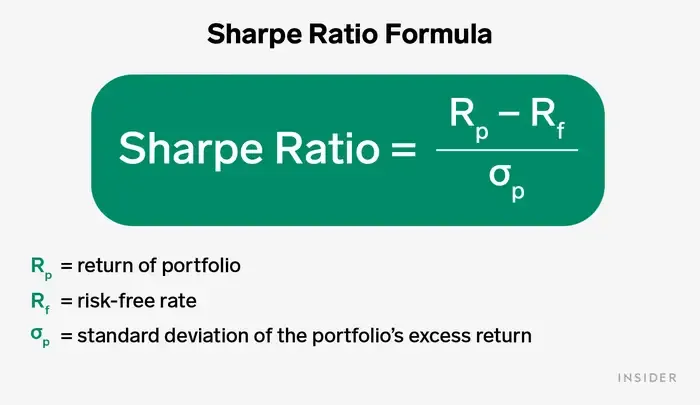
Total cost analysis includes management expense ratios, brokerage fees, currency hedging costs, and foreign exchange spreads.
Global Small Cap ETFs typically charge fees of 0.32-0.55% p.a., while active Global Small Cap Funds often charge 0.75-1.50% p.a.
Lower costs generally improve investors’ long-term international outcomes.
Evaluate Global Small Cap Funds’ track records, assets under management, and operational stability. Established global fund providers like Pengana and Artisan Partners bring long-term track records and specialist skillsets to the Global Small Caps asset class.
Review prospective funds’ top Global Small Cap holdings, the number of international positions, and geographic/sector exposure to understand how diversified they are. Ensure appropriate global market representation across developed countries and avoid over-concentration in specific regions or global sectors.
Analyse each fund’s currency hedging policies, hedging costs, and the effectiveness of their currency risk management.
Also compare active versus passive approaches, considering that active management may add value in the less efficient Global Small Cap market segment.
ESG-focused Global Small Cap funds screen international smaller company markets based on environmental, social, and governance factors. Some Global Small Caps lead in sustainability innovation so this strategy can be well-matched to the asset class.
Global Small Cap Equity Funds offer compelling pathways to participate in international innovation and growth while achieving geographic diversification beyond Australia’s limited Small Cap universe. With over 12,000 smaller companies across 47 countries, the Global Small Cap universe provides access to emerging market leaders and innovative companies which are driving technological advancement. The variety of available funds, from low-cost Global Small Cap index ETFs to actively managed funds, accommodates diverse investor preferences and objectives.
However, Global Small Cap Funds also expose investors to currency volatility risks, economic sensitivity, and liquidity risks which require careful consideration. Success depends on aligning your fund selection with your investment timeframes, risk tolerance, and objectives while maintaining a disciplined, long-term approach. By understanding the various Global Small Cap Fund types, their benefits and risks, and comparison methodologies, investors can make informed decisions. Regular monitoring and rebalancing ensures continued alignment with financial goals and changing global market conditions.